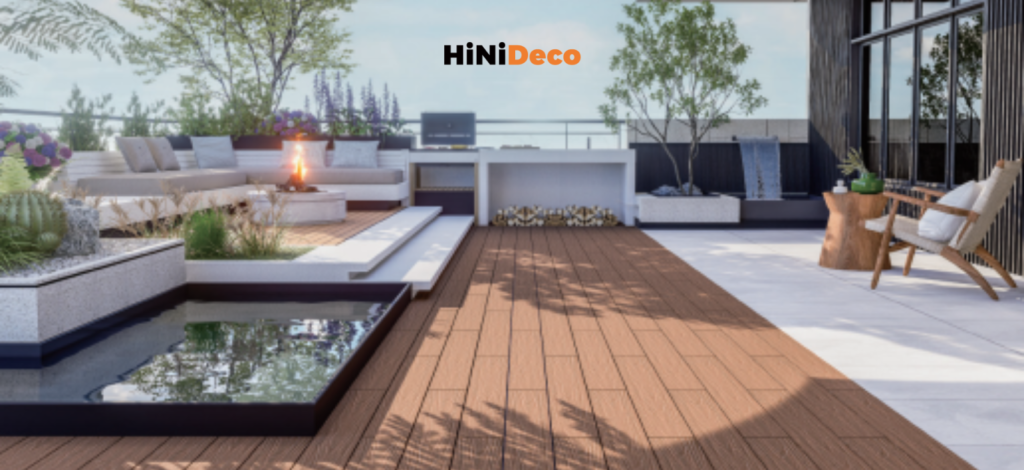What is WPC Decking?
Exterior WPC decking, or Wood-Plastic Composite decking, is a modern building material that combines the natural aesthetics of wood with the durability and low maintenance of plastic. It is made from a blend of recycled wood fibers and plastic materials, creating a product that offers the best of both worlds.
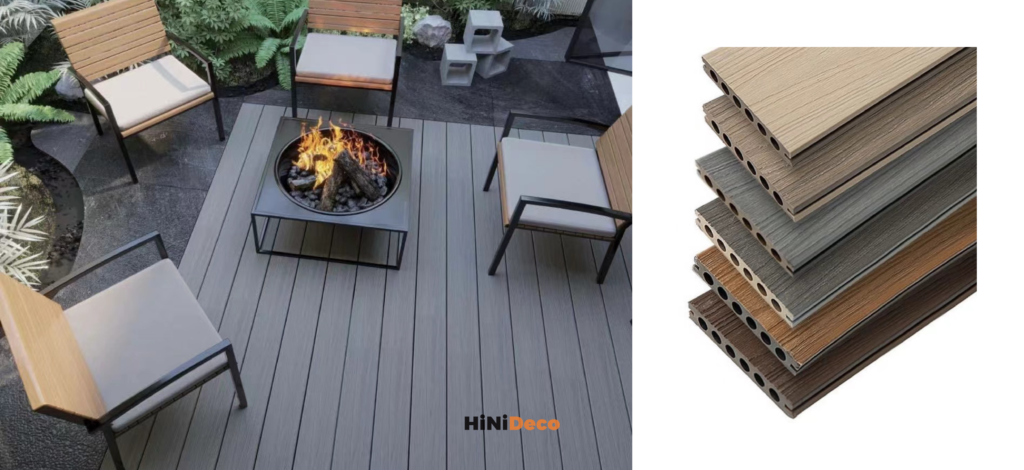
Benefits of Composite Decking
Composite decking, particularly WPC (Wood-Plastic Composite) decking, offers numerous advantages over traditional wood and other materials. Here are some of the key benefits:
1. Durability
- Weather Resistance: Composite decking is designed to withstand harsh weather conditions, including rain, snow, and UV rays, without warping, cracking, or fading.
- Insect Resistance: Unlike natural wood, composite materials are not susceptible to termites and other wood-boring insects.
2. Low Maintenance
- No Staining or Sealing: Composite decking does not require regular staining, sealing, or painting, significantly reducing maintenance efforts and costs.
- Easy Cleaning: A simple wash with soap and water is often enough to keep composite decks looking new.
3. Eco-Friendly
- Recycled Materials: Many composite decking products are made from recycled wood fibers and plastic, making them a sustainable choice for environmentally-conscious consumers.
- Reduced Deforestation: By using recycled materials, composite decking helps reduce the demand for new lumber, contributing to forest conservation.
4. Aesthetic Appeal
- Variety of Styles: Composite decking is available in a wide range of colors, textures, and finishes, allowing homeowners to choose options that match their style.
- Natural Look: Many composite products are designed to mimic the appearance of real wood, providing the beauty of wood without the drawbacks.
5. Safety Features
- Slip Resistance: Composite decking often includes textured surfaces that provide better traction, making it safer for areas near pools or in wet conditions.
- No Splinters: Unlike traditional wood, composite decking does not splinter, making it a safer option for families with children and pets.
6. Cost-Effectiveness
- Long-Term Savings: While the initial cost of composite decking may be higher than wood, the long lifespan and low maintenance requirements can lead to significant savings over time.
- Increased Home Value: Installing composite decking can enhance the overall value of a home, appealing to potential buyers.
7. Versatility
- Multiple Applications: Composite decking can be used for various outdoor applications, including decks, patios, walkways, and even furniture.
- Customizable Designs: Homeowners can create unique outdoor spaces with various layouts, colors, and accessories.
What is WPC Co-Extrusion Decking?
WPC Co-Extrusion Decking is a type of wood-plastic composite decking that features a unique manufacturing process. In this process, a protective layer is co-extruded over the core material, enhancing the decking’s durability, aesthetics, and performance.
Key Features of WPC Co-Extrusion Decking:
- Dual-Layer Construction:
- Core Layer: Made from a composite of wood fibers and plastic, providing structural strength and stability.
- Protective Layer: A thin outer layer of plastic is fused to the core, offering additional protection against moisture, UV rays, and stains.
- Enhanced Durability:
- The co-extruded layer helps prevent fading, scratching, and staining, making it more resilient than traditional WPC decking.
- Low Maintenance:
- Co-extrusion decking requires minimal upkeep. The protective layer makes it easy to clean and less susceptible to mold and mildew growth.
- Aesthetic Appeal:
- Available in a variety of colors and finishes, co-extrusion decking can mimic the look of natural wood while providing a consistent appearance.
- Eco-Friendly:
- Like traditional WPC decking, co-extrusion decking is often made from recycled materials, contributing to sustainability efforts.
- Slip Resistance:
- Many co-extruded products are designed with textured surfaces to improve traction, making them safer for outdoor use, especially in wet conditions.
Advantages of WPC Co-Extrusion Decking:
- Longer Lifespan: The protective layer extends the life of the decking, often lasting 25 years or more.
- Resistance to Weathering: Co-extruded decking performs well in various climates, resisting warping and fading.
- Variety of Styles: Offers a wide range of colors and textures to suit different design preferences.
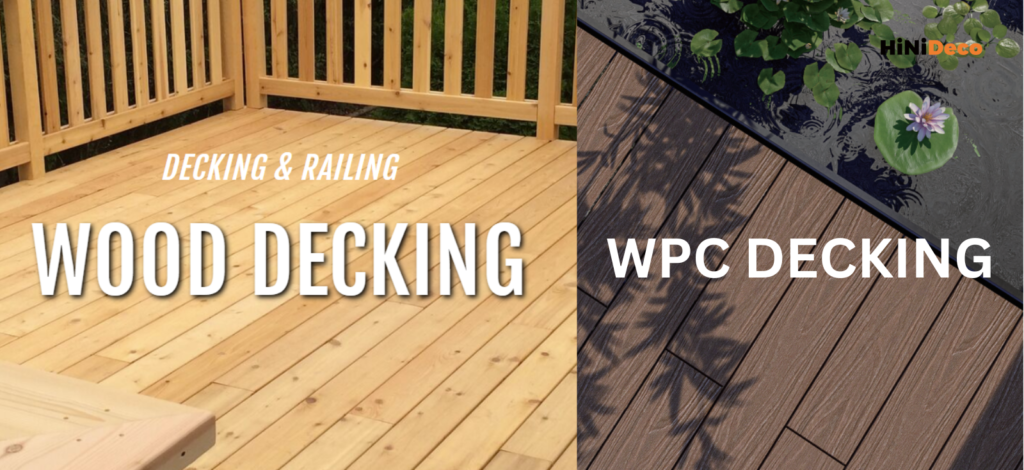
WPC vs. Wood Decking,what’s the difference?
Both WPC and wood decking have their own unique advantages and disadvantages. WPC decking offers durability, low maintenance, and eco-friendliness, making it an excellent choice for many homeowners. On the other hand, wood decking provides a classic aesthetic and may have a lower initial cost, but it requires more maintenance and care. Ultimately, the choice between WPC and wood decking will depend on individual preferences, budget, and intended use.
When choosing between WPC (Wood-Plastic Composite) decking and traditional wood decking, it’s important to understand the key differences, advantages, and disadvantages of each material. Here’s a detailed comparison:
1. Material Composition
- WPC Decking: Made from a blend of recycled wood fibers and plastic, WPC decking combines the aesthetics of wood with the durability of synthetic materials.
- Wood Decking: Typically made from natural wood species like cedar, redwood, or pressure-treated lumber.
2. Durability
- WPC Decking: Highly resistant to rot, insects, and weather conditions. It does not warp or crack easily, making it suitable for various climates.
- Wood Decking: Susceptible to rot, insect damage, and weathering. Requires regular maintenance to preserve its integrity.
3. Maintenance
- WPC Decking: Requires minimal maintenance—no staining, sealing, or painting is needed. Occasional cleaning with soap and water is usually sufficient.
- Wood Decking: Requires regular maintenance, including staining, sealing, and inspections for damage. This can be time-consuming and costly.
4. Aesthetics
- WPC Decking: Available in a variety of colors and textures, many products mimic the look of natural wood while offering consistent coloring and finish.
- Wood Decking: Offers a classic, natural look that many homeowners prefer, but color and grain can vary significantly between boards.
5. Cost
- WPC Decking: Generally has a higher upfront cost compared to traditional wood. However, lower maintenance costs can lead to long-term savings.
- Wood Decking: Usually cheaper to purchase initially, but ongoing maintenance and potential replacement costs can add up over time.
6. Environmental Impact
- WPC Decking: Often made from recycled materials, making it a more sustainable option. Many brands focus on eco-friendly production practices.
- Wood Decking: The environmental impact depends on sourcing. Sustainable wood options exist, but traditional lumber harvesting can contribute to deforestation.
7. Safety
- WPC Decking: Typically designed to be slip-resistant and does not splinter, making it safer for children and pets.
- Wood Decking: Can splinter and may become slippery when wet, posing safety risks.
8. Lifespan
- WPC Decking: Generally has a longer lifespan, often lasting 25 years or more with proper care.
- Wood Decking: Lifespan varies by wood type and maintenance but typically lasts 10-15 years without regular upkeep.
Best WPC Decking Brands worldwide ?
When considering WPC (Wood-Plastic Composite) decking, several brands are known for their quality, durability, and aesthetic appeal. Here are some of the best WPC decking brands:
1. Trex
- Overview: One of the most recognized names in composite decking, Trex offers a wide range of colors and textures.
- Features: Known for its durability, low maintenance, and eco-friendly materials. Trex products often include a protective shell to resist fading and staining.
2. Fiberon
- Overview: Fiberon provides a variety of composite decking options, including traditional and tropical wood looks.
- Features: Offers a 25-year warranty, is made from recycled materials, and features slip-resistant surfaces.
3. TimberTech
- Overview: TimberTech is known for its high-quality composite decking with a focus on sustainability and design.
- Features: Offers a variety of styles, including capped composite options that provide enhanced durability and resistance to moisture.
4. Deckorators
- Overview: Deckorators offers a range of composite decking products that emphasize style and performance.
- Features: Known for its unique designs and textures, as well as its innovative products like the first-ever composite decking with a patented mineral-based core.
5. MoistureShield
- Overview: MoistureShield specializes in composite decking that is designed to be moisture-resistant, making it ideal for wet environments.
- Features: Offers a variety of colors and styles, and its products can be installed on or in the ground, providing versatility.
6. Zuri
- Overview: Zuri is known for its premium composite decking that mimics the look of exotic hardwoods.
- Features: Offers a high level of durability, low maintenance, and a beautiful finish that resists fading and staining.
HiNiDeco from China offer such WPC Decking and wall panel, include the 30x30cm Square decking.
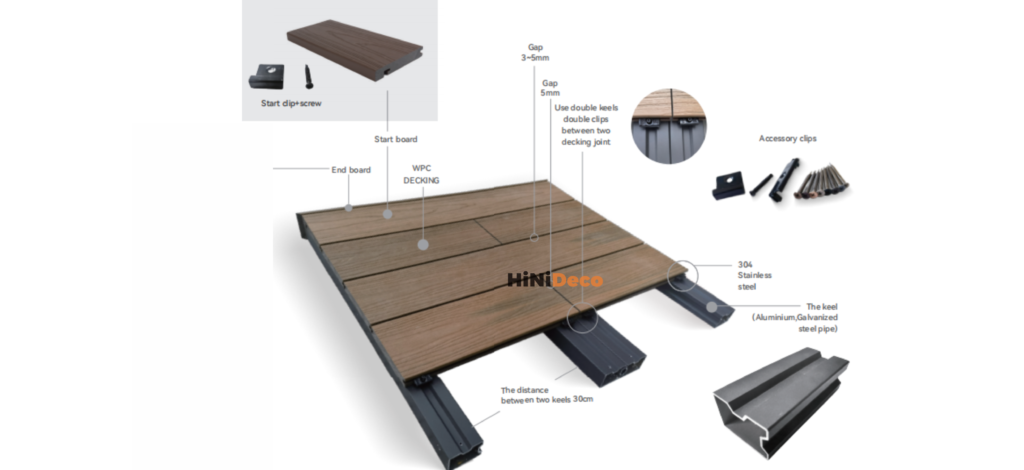
How to install WPC outside decking ?
WPC Co-Extrusion Decking Installation Process
Installing WPC co-extrusion decking involves several steps. Here’s a brief overview of the installation process:
1. Planning and Preparation
- Design Layout: Plan the deck layout, including dimensions and placement of boards.
- Gather Materials: Collect all necessary materials, including decking boards, fasteners, and tools (saw, drill, measuring tape, level, etc.).
- Check Local Codes: Ensure compliance with local building codes and regulations.
2. Preparing the Substructure
- Install Joists: Ensure that the joists are properly spaced (typically 16 inches apart) and securely anchored to the ground or existing structure.
- Level the Surface: Check that the joists are level and make any necessary adjustments.
3. Cutting the Decking Boards
- Measure and Cut: Measure the length needed for each board and cut them to size using a saw. Ensure cuts are straight for proper alignment.
4. Laying the Decking Boards
- Starting Point: Begin laying the boards from one edge, typically the house or a primary support structure.
- Spacing: Leave appropriate gaps between boards for expansion and drainage (usually 1/8 to 1/4 inch).
5. Securing the Boards
- Fastening: Use hidden fasteners or screws to secure the boards to the joists. Follow the manufacturer’s recommendations for fastener types and spacing.
- Check Alignment: Continuously check that the boards are aligned and level as you work.
6. Finishing Touches
- Trim Edges: If necessary, trim the edges of the decking for a clean finish.
- Install Railings: If applicable, install railing systems according to the manufacturer’s instructions.
7. Final Inspection
- Check Stability: Ensure all boards are secure and stable.
- Clean Up: Remove any debris and clean the surface of the decking.
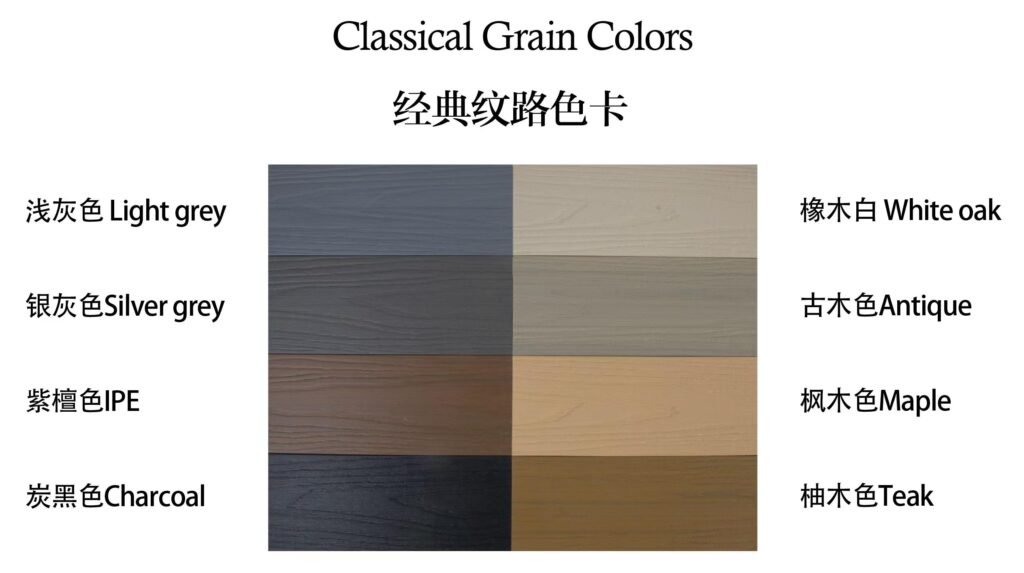
What kind of colors for WPC decking best selling?
For WPC decking, the best-selling colors tend to vary by region and design trends, but generally, certain shades are consistently popular due to their versatility, aesthetic appeal, and ability to complement various outdoor settings, including poolside areas. Here are some of the top-selling WPC decking colors:
1. Wood-Look Browns (Classic Wood Tones)
- Popular Shades: Walnut, Teak, Cedar, Oak
- Why It’s Popular: These natural wood tones offer a timeless, warm aesthetic that blends well with both traditional and contemporary outdoor spaces. They mimic real wood, providing a rustic yet sophisticated look.
- Best For: Residential homes, gardens, pool decks, and outdoor patios.
2. Gray Tones (Modern and Sleek)
- Popular Shades: Ash Gray, Silver Gray, Driftwood
- Why It’s Popular: Gray is an increasingly popular choice due to its modern and minimalistic appearance. It pairs well with contemporary or industrial designs, offering a sleek and elegant look.
- Best For: Modern homes, urban settings, contemporary pool areas, and coastal environments.
3. Dark Charcoal (Sophisticated and Elegant)
- Popular Shades: Charcoal, Slate, Graphite
- Why It’s Popular: Darker colors like charcoal add a sophisticated and luxurious touch to outdoor spaces. They are particularly favored for upscale properties or those looking for a more dramatic contrast.
- Best For: Luxury properties, upscale pool decks, and urban-style outdoor spaces.
4. Light Beige or Tan (Warm and Neutral)
- Popular Shades: Sandstone, Desert, Honey, Almond
- Why It’s Popular: Light, neutral tones are versatile and match almost any style or decor. These shades are warm and inviting, and they create a relaxed, beachy atmosphere, especially in pool or spa areas.
- Best For: Coastal homes, beachside pool decks, or residential gardens.
5. Red and Mahogany Tones (Rich and Bold)
- Popular Shades: Red Cedar, Mahogany, Rosewood
- Why It’s Popular: These rich, bold tones are perfect for creating a statement in outdoor spaces. They offer a luxurious look that can add warmth and a touch of elegance to decks, particularly around pools.
- Best For: Luxury pool decks, garden spaces, and high-end residential designs.
6. Mixed or Multi-Tonal (Unique and Stylish)
- Popular Shades: A combination of gray and brown tones, or wood tones with hints of charcoal or red
- Why It’s Popular: Multi-tonal decking mimics the look of natural wood with more variety and depth. This style is gaining popularity because of its ability to create a dynamic, textured look with a modern twist.
- Best For: Modern designs, contemporary spaces, and those wanting to create a unique outdoor vibe.
Key Considerations:
- Matching with Surroundings: Choose a color that complements the pool’s design, landscaping, and the overall aesthetic of the property.
- Maintenance: Lighter colors may show dirt more easily, while darker tones can show water spots. Consider how the color will look over time and with exposure to pool chemicals.
- Trends: While classic wood tones remain popular, modern grays and dark shades are trending, especially in urban and contemporary designs.
Would you like to explore some sample collections based on these colors, or discuss which color would suit a particular project best?
Professional Installation Recommendation
While WPC co-extrusion decking can be a DIY project for those with carpentry skills, professional installation is recommended for several reasons:
- Expertise: Professionals have experience with the proper techniques and tools required for a successful installation.
- Time Efficiency: Hiring professionals can save time, especially for larger projects.
- Warranty Compliance: Some manufacturers may require professional installation to maintain warranty coverage.
- Quality Assurance: Professional installers can ensure that the decking is installed correctly, reducing the risk of issues like warping or improper drainage.
Cost Considerations for WPC Decking
When evaluating WPC (Wood-Plastic Composite) decking, it’s important to consider both the initial investment and long-term savings. Here’s a breakdown of these cost factors:
1. Initial Investment
- WPC Decking Costs:
- The average cost of WPC decking ranges from $2 to $10 per linear foot, depending on the brand, quality, and features (like co-extrusion).
- Installation costs can add an additional $5 to $15 per square foot, depending on the complexity of the project and local labor rates.
- Traditional Wood Decking Costs:
- Natural wood decking (like cedar or redwood) typically ranges from $3 to $7 per linear foot.
- Pressure-treated lumber is often the cheapest option, costing about $1 to $5 per linear foot.
- Installation costs are similar, ranging from $5 to $15 per square foot.
2. Long-Term Savings
- Maintenance Costs:
- WPC Decking: Requires minimal maintenance—occasional cleaning with soap and water. No staining, sealing, or painting is needed, which saves time and money.
- Traditional Wood Decking: Requires regular maintenance, including staining and sealing every few years. This can cost anywhere from $1 to $3 per square foot annually.
- Lifespan:
- WPC Decking: Typically lasts 25 years or more with proper care, reducing the need for replacement.
- Traditional Wood Decking: Generally lasts 10 to 15 years without regular upkeep, leading to potential replacement costs.
- Resale Value:
- Both WPC and wood decking can enhance property value, but WPC may offer a better return on investment due to its durability and low maintenance appeal.
3. Total Cost Comparison Over Time
- WPC Decking:
- Initial Cost: Higher upfront investment.
- Maintenance Cost: Low or negligible over time.
- Total Cost Over 25 Years: Lower overall due to minimal maintenance and longer lifespan.
- Traditional Wood Decking:
- Initial Cost: Lower upfront investment.
- Maintenance Cost: Higher ongoing costs due to regular maintenance and potential repairs.
- Total Cost Over 15 Years: Can become comparable or even higher than WPC due to replacement needs and maintenance expenses.
Common Myths and Misconceptions About WPC Decking
Despite its growing popularity, WPC (Wood-Plastic Composite) decking is often surrounded by myths and misconceptions. Here are some of the most common ones, along with the truths that debunk them:
1. Myth: WPC Decking is Less Durable Than Wood
- Truth: WPC decking is engineered for durability. It is resistant to rot, mold, and insect damage, which are common issues with traditional wood. Many WPC products come with warranties of 25 years or more, proving their longevity.
2. Myth: WPC Decking is More Expensive in the Long Run
- Truth: While the initial cost of WPC decking may be higher than traditional wood, the long-term savings from reduced maintenance, repair, and replacement costs often make it more economical over time. WPC requires minimal upkeep compared to wood, which needs regular staining and sealing.
3. Myth: WPC Decking Looks Artificial
- Truth: Modern WPC decking is designed to mimic the appearance of natural wood closely. With various colors, textures, and finishes available, it can enhance the aesthetic appeal of outdoor spaces just as well as traditional wood.
4. Myth: WPC Decking Gets Too Hot in the Sun
- Truth: While all decking materials can heat up in direct sunlight, many WPC products are designed with heat-resistant properties and textures that can help mitigate this issue. Additionally, lighter colors tend to absorb less heat than darker ones.
5. Myth: WPC Decking is Slippery
- Truth: Many WPC decking options are designed with slip-resistant surfaces, making them safer for wet conditions. Manufacturers often test and promote their products’ slip resistance.
6. Myth: WPC Decking is Not Environmentally Friendly
- Truth: WPC decking is often made from recycled materials, including wood fibers and plastic. Many brands prioritize sustainability, making WPC a more eco-friendly choice compared to traditional wood, which can contribute to deforestation.
7. Myth: WPC Decking Requires Special Fasteners
- Truth: While some WPC products may recommend specific fasteners for optimal performance, many can be installed with standard decking screws. It’s essential to follow the manufacturer’s guidelines for best results.
Maintenance Tips for WPC Decking
To ensure the longevity and appearance of WPC (Wood-Plastic Composite) decking, proper care and maintenance are essential. Here are some practical tips to help you prolong its lifespan:
1. Regular Cleaning
- Frequency: Clean your WPC decking at least twice a year, or more often in heavily trafficked areas.
- Method: Use a broom or leaf blower to remove debris, followed by a gentle scrub with soap and water using a soft-bristle brush. Avoid harsh chemicals or abrasive cleaners.
2. Stain Removal
- Immediate Action: Clean up spills (like food, drinks, or oils) immediately to prevent staining.
- Stain Treatment: For tough stains, use a mixture of warm water and mild detergent. For grease or oil stains, a specialized cleaner may be necessary.
3. Avoiding Heavy Furniture
- Weight Distribution: Use furniture pads or coasters under heavy furniture to prevent indentations or scratches on the decking surface.
- Movement: Regularly move furniture to avoid uneven wear and fading.
4. Preventing Mold and Mildew
- Moisture Control: Ensure proper drainage around the decking area to prevent standing water. Use a pressure washer with a mild detergent to clean areas prone to mold or mildew.
- Sunlight Exposure: Trim nearby trees or shrubs to allow sunlight to reach the decking, helping to reduce moisture retention.
5. Protecting Against Scratches
- Footwear: Encourage the use of soft-soled shoes on the deck to minimize scratches.
- Pet Care: Keep pet nails trimmed to prevent scratching the surface.
6. Seasonal Maintenance
- Winter Care: Remove snow and ice using a plastic shovel or broom. Avoid using metal shovels or sharp tools that can scratch the surface.
- Summer Care: Check for any loose boards or fasteners and tighten them as needed.
7. Inspection
- Regular Checks: Periodically inspect the decking for signs of wear, loose boards, or damaged fasteners. Address any issues promptly to prevent further damage.
8. Follow Manufacturer Guidelines
- Specific Instructions: Always refer to the manufacturer’s care instructions and recommendations for cleaning products, maintenance schedules, and warranty conditions.
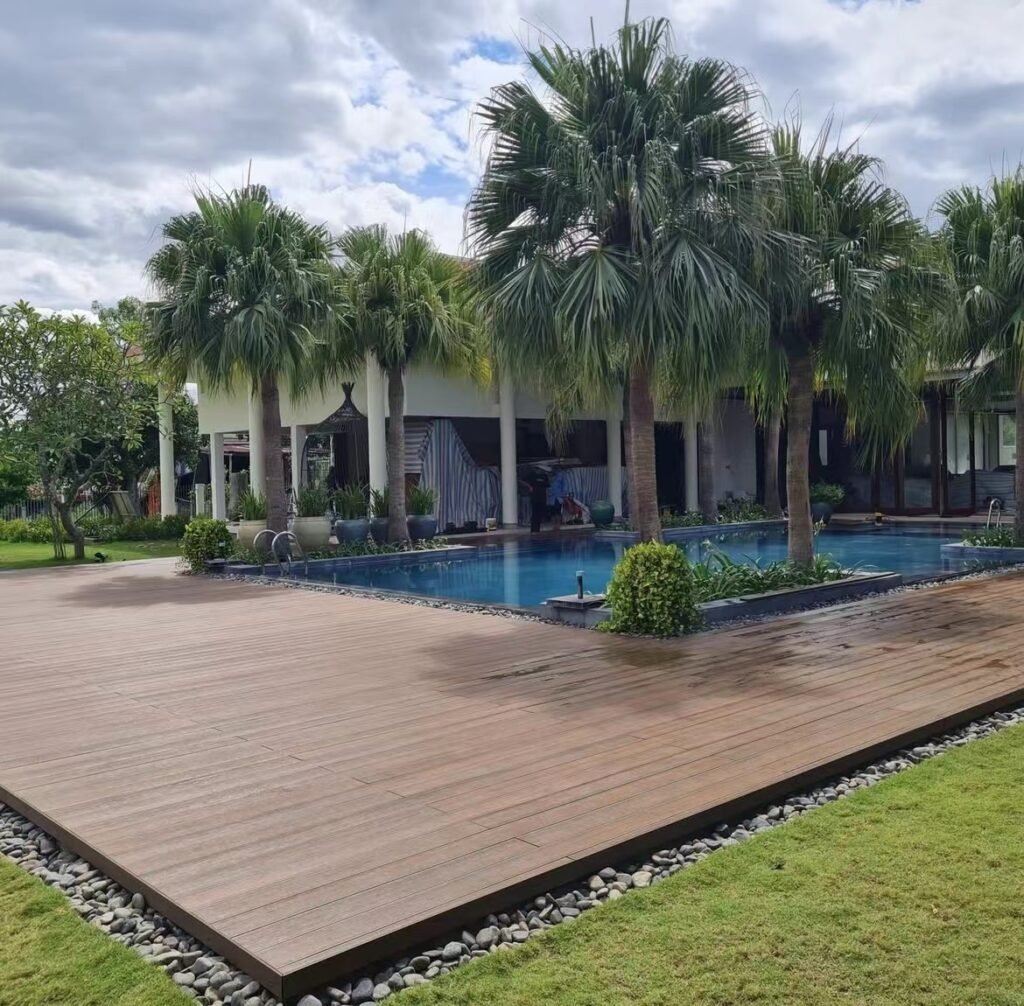
Real-Life Applications and Case Studies of WPC Decking
WPC (Wood-Plastic Composite) decking has been successfully utilized in various applications, showcasing its versatility and appeal. Here are a few examples and testimonials from satisfied customers:
1. Residential Outdoor Living Spaces
- Project Overview: A homeowner in Columbia transformed their backyard into a luxurious outdoor living area with WPC decking.
- Features: The installation included a large deck with built-in seating, a fire pit, and ambient lighting.
- Customer Testimonial: “We love our new deck! It looks stunning and requires so little maintenance compared to our old wooden deck. We can enjoy our outdoor space without worrying about constant upkeep.”
2. Commercial Patios
- Project Overview: A restaurant in Chile opted for WPC decking for its outdoor dining area to enhance aesthetics and durability.
- Features: The deck was designed with slip-resistant surfaces and integrated planters for a vibrant atmosphere.
- Customer Testimonial: “Our outdoor seating area has become a favorite spot for customers. The WPC decking not only looks great but has held up beautifully against the elements. We’re thrilled with the choice!”
3. Poolside Decking
- Project Overview: A family in Hungry installed WPC decking around their pool to create a safe and stylish environment.
- Features: The decking included built-in seating and a non-slip surface for safety.
- Customer Testimonial: “We were concerned about slippery surfaces around the pool, but the WPC decking has exceeded our expectations. It’s safe, easy to clean, and still looks brand new after a year!”
4. Community Parks
- Project Overview: A municipal park in Honduras upgraded its picnic areas with WPC decking to provide a sustainable and low-maintenance solution.
- Features: The installation included multiple picnic tables and benches made from WPC materials.
- Customer Feedback: “The new decking has made our park more inviting and functional. It’s environmentally friendly, and we appreciate how easy it is to maintain.”
5. Rooftop Decks
- Project Overview: An urban apartment complex in Spain City utilized WPC decking for its rooftop terrace to maximize outdoor space for residents.
- Features: The deck features lounge areas, planters, and a barbecue zone.
- Customer Testimonial: “Our rooftop is now a community hub thanks to the WPC decking. It’s stylish and has held up well against the city’s harsh weather. Residents love spending time outdoors!”
Explore HiNiDeco’s WPC Decking Products!
Are you ready to transform your outdoor space with durable, stylish, and low-maintenance WPC decking? At HiNiDeco, we offer a wide range of high-quality WPC decking products designed to meet your needs and elevate your outdoor living experience.
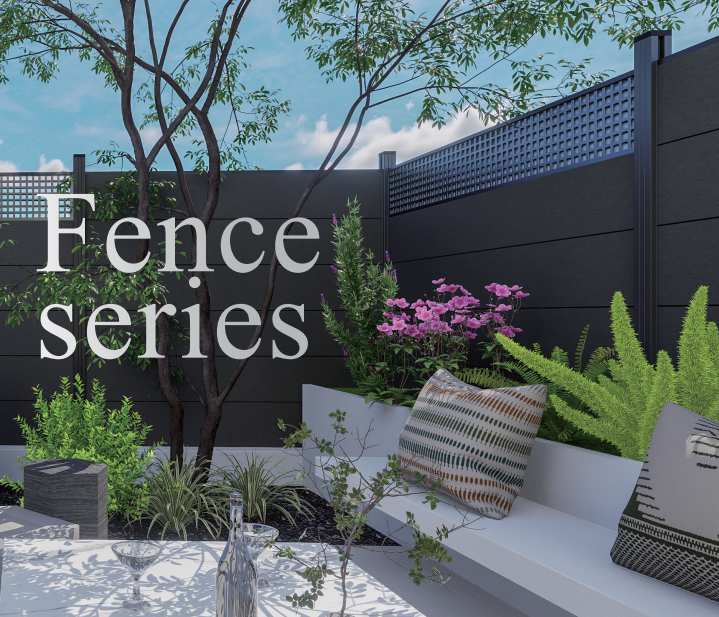
WPC Fencing: Overview and Benefits
WPC (Wood-Plastic Composite) fencing is an innovative solution that combines the best properties of wood and plastic, offering a durable and aesthetically pleasing alternative to traditional wood fencing. Here’s a detailed look at WPC fencing, including its features, benefits, and installation tips.
1. What is WPC Fencing?
WPC fencing is made from a mixture of wood fibers and plastic materials, which are combined to create a composite material that mimics the appearance of wood while providing enhanced durability and resistance to the elements.
2. Benefits of WPC Fencing
- Durability: WPC fencing is resistant to rot, mold, and insect damage, making it a long-lasting choice compared to traditional wood.
- Low Maintenance: Unlike wood, WPC fencing does not require painting, staining, or sealing. A simple wash with soap and water is usually sufficient to keep it clean.
- Aesthetic Appeal: Available in various colors and textures, WPC fencing can replicate the look of natural wood while offering more design flexibility.
- Eco-Friendly: Made from recycled materials, WPC fencing is a sustainable option that reduces the demand for virgin wood.
- Weather Resistance: WPC materials are designed to withstand harsh weather conditions, including rain, snow, and UV exposure, without warping or fading.
3. Applications of WPC Fencing
- Residential Properties: Ideal for backyards, gardens, and pool areas, providing privacy and security.
- Commercial Spaces: Used in parks, outdoor venues, and commercial properties for decorative and functional fencing solutions.
- Boundary Fencing: Effective for marking property lines while adding an attractive element to the landscape.
4. Installation Tips
- Preparation: Ensure the ground is level and clear of debris before installation. Mark the fence line for accurate placement.
- Post Installation: Install fence posts securely in concrete for stability. Ensure they are aligned and spaced according to the design specifications.
- Panel Attachment: Attach the WPC panels to the posts using appropriate fasteners. Follow the manufacturer’s guidelines for spacing and alignment.
- Finishing Touches: Add caps or decorative elements to the top of the fence for a polished look.
5. Maintenance of WPC Fencing
Inspection: Check for any loose panels or fasteners and address issues promptly to maintain the integrity of the fence.
Regular Cleaning: Wash the fence periodically to remove dirt and debris. A mild detergent can be used for tougher stains.
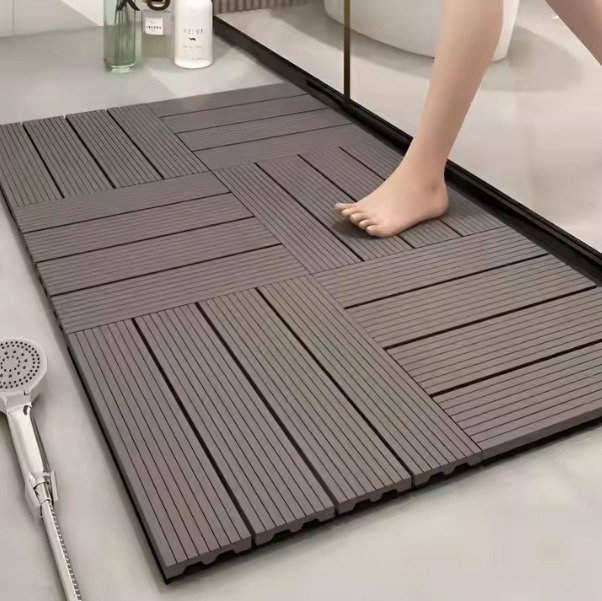
WPC Decking Floor Tiles: Overview and Benefits
WPC (Wood-Plastic Composite) decking floor tiles are an excellent choice for outdoor and indoor flooring solutions. They combine the natural aesthetics of wood with the durability and low maintenance of plastic, making them increasingly popular in various applications.
1. What are WPC Decking Floor Tiles?
WPC decking floor tiles are made from a blend of wood fibers and thermoplastic materials. This composite material is designed to mimic the appearance of natural wood while offering enhanced durability and resistance to environmental factors.
2. Benefits of WPC Decking Floor Tiles
- Durability: WPC tiles are resistant to rot, mold, and insect damage, ensuring a longer lifespan compared to traditional wood tiles.
- Low Maintenance: They require minimal upkeep—occasional cleaning with soap and water is usually sufficient.
- Aesthetic Variety: Available in various colors, textures, and finishes, WPC tiles can complement any design style, from contemporary to rustic.
- Eco-Friendly: Many WPC products are made from recycled materials, making them a sustainable choice for environmentally conscious consumers.
- Weather Resistance: WPC tiles can withstand harsh weather conditions, making them suitable for outdoor patios, decks, and pool areas.
3. Applications of WPC Decking Floor Tiles
- Outdoor Spaces: Ideal for patios, decks, balconies, and poolside areas due to their slip-resistant properties.
- Indoor Areas: Can be used in sunrooms, mudrooms, or even as flooring in commercial spaces like cafes and restaurants.
- Event Spaces: Perfect for temporary installations at events or exhibitions due to their easy installation and removal.
4. Installation Tips
- Surface Preparation: Ensure the installation surface is clean, level, and free of debris.
- Layout Planning: Plan the layout before installation to avoid cutting tiles unnecessarily and to achieve the desired aesthetic.
- Interlocking System: Many WPC tiles feature an interlocking design, making installation straightforward without the need for adhesives.
- Expansion Gaps: Leave adequate gaps between tiles to allow for expansion and contraction due to temperature changes.
5. Maintenance of WPC Decking Floor Tiles
- Regular Cleaning: Sweep or vacuum to remove dirt and debris. Use a mild detergent for deeper cleaning.
- Inspect for Damage: Regularly check for any signs of wear or damage and address issues promptly to maintain the integrity of the flooring.
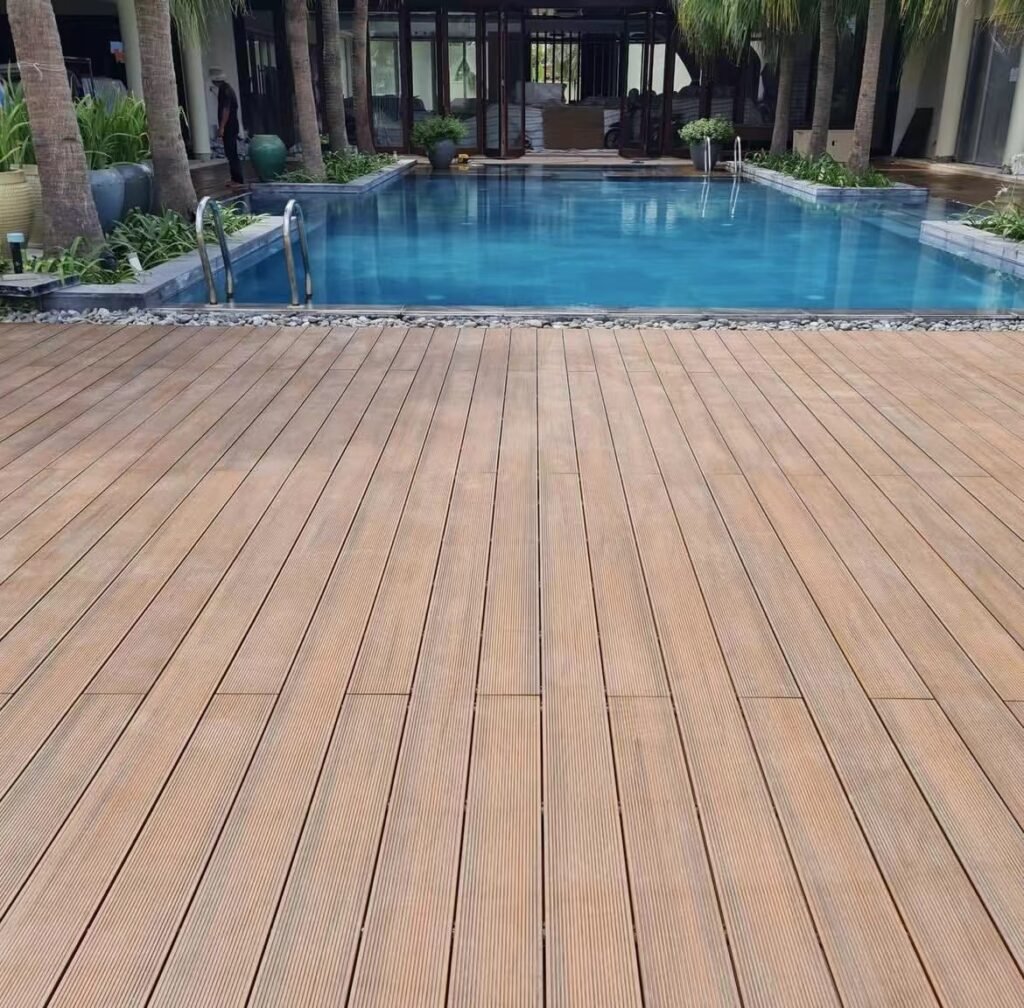
How to Incorporate WPC Decking Around a Swimming Pool:
- Surround the Pool: Install WPC decking around the perimeter of the pool for a stylish and durable surface.
- Create Lounge Areas: Use WPC decking to build poolside lounges or sunbathing platforms.
- Step & Walkways: Consider WPC for pool steps or pathways leading to the pool for a uniform, polished look.
Why Choose HiNiDeco’s WPC Decking?
- Durability: Engineered to withstand the elements and resist rot, mold, and insects.
- Aesthetic Appeal: Available in various colors and textures to mimic the beauty of natural wood.
- Low Maintenance: Enjoy your outdoor space without the hassle of frequent upkeep.
Get Started Today!
- Explore Our Products: HiNiDeco WPC Decking Products
- Contact Us for Inquiries:
- Email: sales@hinideco.com
- Phone: +86 19817052520
Don’t miss out on the opportunity to enhance your outdoor area with our premium WPC decking solutions. Contact us today to learn more or to request a quote!

